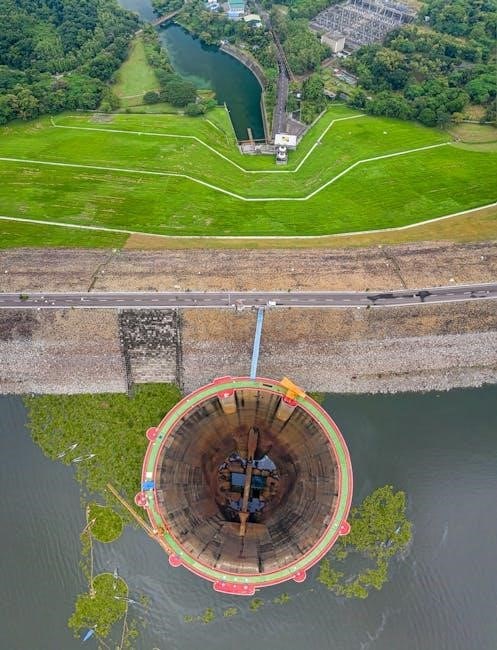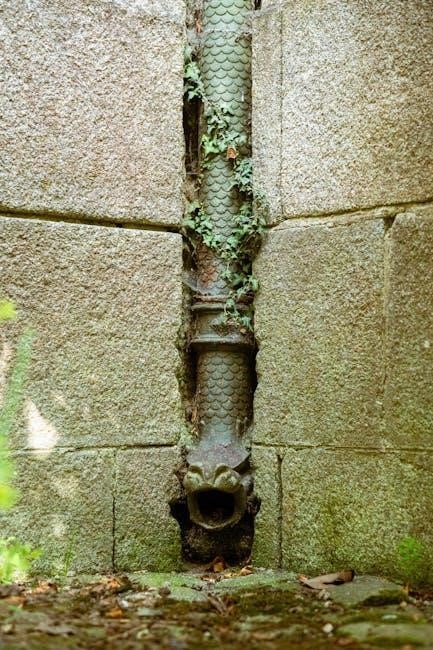The PleurX catheter system is a medical solution for managing fluid buildup in the pleural or peritoneal space. Proper drainage techniques are essential for safety and effectiveness, ensuring patient comfort and preventing complications. This guide provides step-by-step instructions for using the PleurX system, emphasizing aseptic technique and patient education for successful home management.
1.1 Overview of the PleurX Catheter System
The PleurX catheter system is a minimally invasive medical device designed for draining excess fluid from the pleural or peritoneal space. It consists of a tunneled catheter with a distal fenestrated drainage tube and a one-way valve, allowing fluid to exit the body while preventing air or other substances from entering. This system is typically used for patients with conditions like pleural effusion or ascites, enabling them to manage fluid drainage at home. The PleurX system is known for its ease of use and patient-friendly design, reducing the need for frequent medical interventions. Proper training and adherence to drainage guidelines are essential for safe and effective use, ensuring patient comfort and minimizing complications.
1.2 Importance of Proper Drainage Techniques
Proper drainage techniques are crucial for the safe and effective use of the PleurX catheter system. Incorrect methods can lead to complications such as infections, catheter blockages, or fluid leakage. Adhering to aseptic technique during drainage and dressing changes minimizes the risk of infection, ensuring the catheter remains a safe and reliable solution for managing fluid buildup. Additionally, monitoring drainage volume and appearance helps in early detection of potential issues, allowing for timely medical intervention. Proper techniques also enhance patient comfort and maintain the integrity of the catheter, prolonging its functionality and improving overall outcomes. By following established guidelines, patients and caregivers can effectively manage the PleurX system, ensuring optimal results and minimizing risks associated with its use.
Understanding the PleurX Catheter
The PleurX catheter is a medical device designed to safely drain fluid from the pleural or peritoneal space, offering a comfortable and effective solution for patients requiring fluid management.
2.1 What is a PleurX Catheter?
A PleurX catheter is a soft, flexible tube inserted into the pleural or peritoneal space to drain excess fluid, such as pleural effusion or ascites, from the body. It is designed for long-term use and allows patients or caregivers to perform drainage at home. The catheter is connected to a drainage system that collects the fluid, providing relief from symptoms like shortness of breath or abdominal discomfort. Its design minimizes discomfort and promotes ease of use, making it a preferred option for managing chronic fluid accumulation. Proper care and maintenance are essential to ensure the catheter functions effectively and prevents complications.
2.2 Components of the PleurX Drainage System

The PleurX drainage system consists of several key components designed to facilitate safe and effective fluid drainage. The primary component is the PleurX catheter, a soft, flexible tube inserted into the pleural or peritoneal space. Attached to the catheter is a drainage tube, which connects to a collection chamber for fluid accumulation. A clamp is included to control the flow of fluid during drainage. Additionally, a self-adhesive dressing secures the catheter to the skin, minimizing movement and reducing the risk of dislodgment. The system may also include a needle-less access port for optional flushing or administering medications. These components work together to ensure efficient drainage and patient comfort, with a design emphasizing ease of use and portability.

Preparing for PleurX Drainage
Gather all necessary supplies, including the PleurX drainage kit, sterile gloves, and cleaning materials. Ensure a clean environment and proper training in aseptic technique for safe drainage.
3.1 Gathering Necessary Supplies
To prepare for PleurX drainage, gather all essential supplies, including the PleurX drainage kit, sterile gloves, antiseptic solution, gauze pads, and a clean drainage container. Ensure the drainage bag is compatible with the PleurX system and properly sealed. Organize the supplies in a clean, accessible area to maintain efficiency during the procedure. Always follow the manufacturer’s instructions for specific items required. Proper preparation helps minimize the risk of contamination and ensures a smooth drainage process. If unsure about any supplies, consult your healthcare provider or the PleurX system guidelines for clarification.

3.2 Using Aseptic Technique
Using aseptic technique is critical to prevent infections during PleurX catheter drainage. Begin by washing your hands thoroughly with soap and water. Don a pair of sterile gloves to minimize the risk of contamination. Ensure the catheter insertion site is cleaned with an antiseptic solution, following the manufacturer’s guidelines. Maintain a clean and organized workspace, keeping all supplies within reach. Avoid touching non-sterile surfaces or objects once gloves are on. If assisting a patient, guide them to follow the same hygiene practices. Proper aseptic technique ensures the procedure remains safe and reduces the likelihood of complications. Always monitor the site for signs of infection, such as redness or swelling, and report any concerns to a healthcare provider promptly.

Step-by-Step Drainage Process
Open the clamp on the drainage tube to initiate fluid flow. Monitor the amount and appearance of fluid closely. For chest drainage, limit to 1000ml per session to avoid complications. Always follow aseptic technique and manufacturer guidelines to ensure safe and effective drainage. Adjust as needed based on patient comfort and clinical recommendations.
4.1 Opening the Clamp on the Drainage Tube
Begin by opening the clamp on the drainage tube to allow fluid to flow out. Ensure the process is done smoothly to avoid introducing air into the system. Always use aseptic technique to minimize infection risks. For chest drainage, do not exceed 1000ml per session to prevent complications. If draining from the abdomen, drain to patient comfort, but be aware that volumes under 1000ml may require more frequent drainage, while over 2000ml could indicate insufficient drainage frequency. Monitor the fluid’s appearance and amount closely, documenting any abnormalities. If concerns arise, consult your healthcare provider immediately. Properly close the clamp after drainage to maintain system integrity.
4.2 Monitoring Fluid Drainage
During drainage, closely monitor the fluid’s flow, amount, and appearance. Ensure the fluid drains freely without kinking the tube. For pleural drainage, limit the volume to 1000ml per session to avoid complications. For abdominal drainage, adjust based on patient comfort, but note that volumes under 1000ml may require more frequent drainage, while over 2000ml could indicate insufficient frequency. Always use aseptic technique to prevent infection. Document the amount, color, and consistency of the fluid, as well as any unusual odors or particles. If you notice blood, pus, or cloudy fluid, stop the process and contact your healthcare provider immediately. Monitoring helps ensure safe and effective drainage while maintaining patient comfort and system integrity.
4.3 Limitations on Fluid Volume

Adhere to specific fluid volume limits during drainage to ensure safety and effectiveness. For pleural catheters, never drain more than 1000ml at one time to prevent complications. If the catheter is in the abdomen, drain to the patient’s comfort, but be aware that draining less than 1000ml may require more frequent sessions, while volumes exceeding 2000ml could indicate insufficient drainage frequency. Always monitor the fluid’s appearance and volume, documenting these details in the patient’s record. If unusual symptoms arise, such as blood or pus in the fluid, stop the process immediately and consult a healthcare provider. These guidelines help maintain patient safety and optimize the drainage process.

Dressing and Catheter Care
Proper dressing and catheter care are crucial to prevent infections and ensure functionality. Change the dressing daily or as needed, using aseptic technique. Secure the catheter firmly to avoid dislodgment, and clean the site regularly. A home care nurse may assist with these tasks to maintain patient safety and comfort.
5.1 Changing the Dressing
Changing the dressing is a critical step in maintaining catheter care. Begin by gathering all necessary supplies, including sterile gloves, antiseptic solution, and a new dressing. Wash your hands thoroughly and put on gloves to minimize the risk of infection. Gently remove the old dressing, taking care not to disturb the catheter. Clean the catheter site with an antiseptic solution, ensuring it is free from any drainage or debris. Allow the area to dry completely before applying the new dressing. Secure the dressing firmly to prevent it from shifting. Properly dispose of the old dressing and gloves. If unsure, refer to the manufacturer’s guidelines or consult a healthcare professional for assistance. Regular dressing changes help prevent infections and ensure the catheter remains functional.
5.2 Securing the Catheter
Securing the PleurX catheter is essential to prevent dislodgment and ensure proper function. After changing the dressing, use medical tape to firmly attach the catheter to the skin, avoiding excessive tightness that could cause discomfort. Ensure the catheter is positioned in a way that minimizes kinking or twisting. For added stability, consider using a securement device specifically designed for catheters. Regularly inspect the catheter and its securement to ensure it remains in place. Patients should avoid tight clothing that may rub against the catheter site. If the catheter feels loose or unstable, contact a healthcare provider immediately. Proper securement helps prevent complications and maintains the integrity of the catheter system.

Monitoring and Documentation
Regularly monitor drainage amount, appearance, and patient response. Document findings, including fluid volume and characteristics, to track progress and guide further treatment. Accurate records ensure optimal care.
6.1 Assessing Drainage Amount and Appearance
Monitor the amount of fluid drained, ensuring it does not exceed recommended limits (e.g., 1000ml for pleural drainage). Note the fluid’s color, clarity, and consistency. Normal pleural fluid is pale yellow and clear, while abnormal fluid may appear cloudy, bloody, or serosanguinous. Document any changes in drainage characteristics, as they may indicate infection, inflammation, or other complications. Assessing drainage regularly helps track treatment progress and ensures patient safety. Record findings accurately, including volume and appearance, to guide clinical decisions and maintain continuity of care. Any unusual observations should be reported to healthcare providers promptly for evaluation and appropriate intervention.
6.2 Documenting Patient Response
Accurate documentation of the patient’s response to drainage is crucial for ongoing care. Record the volume and appearance of the drained fluid, as well as any changes in the patient’s symptoms, such as reduced shortness of breath or discomfort. Note the patient’s overall comfort level during and after the procedure. Document any adverse reactions, such as pain, dizziness, or signs of infection. Include observations of the catheter site, ensuring it remains clean and free from redness or swelling. Maintain detailed records of each drainage session, including the date, time, and amount of fluid drained. This documentation aids healthcare providers in assessing treatment effectiveness and making informed decisions. Regular updates ensure continuity of care and patient safety.

Patient Education and Support
Patient education is crucial for safe and effective use of the PleurX catheter. Teach patients and caregivers about proper drainage techniques, catheter care, and infection prevention. Ensure they understand the importance of aseptic technique and regular drainage schedules. Provide written instructions and demonstrate procedures to build confidence. Encourage patients to monitor for complications and report concerns promptly. Offer ongoing support through follow-up appointments or home care services to address any questions or issues. Proper training empowers patients to manage their condition independently, improving quality of life and treatment outcomes.
7.1 Teaching Patients and Caregivers
Teaching patients and caregivers is essential for successful management of the PleurX catheter. Begin with clear explanations of the catheter’s purpose and proper drainage techniques. Use visual aids, such as instructional videos or diagrams, to reinforce understanding. Demonstrate step-by-step how to open the clamp, drain fluid, and secure the catheter. Emphasize the importance of aseptic technique to prevent infections. Provide written instructions for reference and ensure patients understand when and how to monitor drainage amounts. Address any concerns or questions they may have. Encourage caregivers to assist with tasks like dressing changes or securing the catheter. Hands-on practice under supervision can build confidence. Regular follow-ups or home visits by healthcare providers can further support their learning and address any emerging issues.
7.2 Scheduling Regular Drainage
Regular drainage is crucial for managing fluid accumulation effectively. Patients should drain fluid daily or every other day, as directed by their healthcare provider. Use a one-liter bottle for drainage, ensuring not to exceed 1000ml at one time for chest catheters. For abdominal catheters, drain to patient comfort, adjusting frequency based on fluid volume. Documenting drainage amount, appearance, and patient response is essential for monitoring progress. Establishing a routine helps maintain catheter function and prevents complications. Patients should be taught to recognize signs indicating the need for more frequent drainage, such as increased shortness of breath or discomfort. Always consult healthcare providers before making changes to the drainage schedule to ensure optimal management and patient safety.
Safety Precautions
Adhere to infection prevention guidelines, use aseptic technique during drainage, and monitor for complications like infection or catheter blockage to ensure safe and effective catheter management.
8.1 Preventing Infections
Preventing infections is critical when using the PleurX catheter. Always use aseptic technique during drainage and dressing changes to minimize the risk of bacterial contamination. Wash hands thoroughly with soap and water before handling the catheter or supplies. Use sterile gloves and ensure all materials, such as drainage bottles and dressings, are sterile. Secure the catheter properly to prevent movement, which can irritate the skin and increase infection risk. Regularly inspect the catheter site for redness, swelling, or pus, and report any signs of infection to your healthcare provider immediately. Maintain a clean environment during drainage procedures and avoid touching the catheter or drainage system unnecessarily. Documenting drainage amount, appearance, and any abnormalities helps in early detection of potential issues.
8.2 Avoiding Complications
To avoid complications with the PleurX catheter, adhere to recommended drainage limits and monitor for signs of issues. For pleural catheters, never drain more than 1000ml at one time to prevent lung injury. If the catheter is in the abdomen, drain to patient comfort, but avoid frequent small volumes or excessive amounts. Regularly inspect the catheter and site for kinking, blockages, or dislodgment. Ensure the catheter is securely anchored to prevent movement. Watch for signs of complications, such as increased pain, shortness of breath, or difficulty draining, and report them to your healthcare provider immediately. Proper catheter care and adherence to drainage guidelines help minimize risks and ensure safe, effective use of the PleurX system.

Follow-Up Care
Regular follow-up appointments are crucial to monitor catheter function and overall patient health. Assess the catheter site for signs of infection or malfunction during these visits. Addressing concerns promptly ensures optimal outcomes and prevents complications.
9.1 Routine Check-Ups
Routine check-ups are essential to ensure the proper functioning of the PleurX catheter and overall patient well-being. During these visits, healthcare providers assess the catheter site for signs of infection, such as redness, swelling, or drainage. They also evaluate the effectiveness of fluid drainage and monitor for any complications. Patients should be educated on observing and reporting any unusual symptoms, such as increased pain or shortness of breath. Regular imaging or lab tests may be recommended to check fluid levels and lung function. These check-ups help maintain catheter patency, prevent issues, and ensure the patient’s comfort and safety. Consistent follow-up care is vital for managing chronic conditions effectively.
9.2 Addressing Concerns
Addressing concerns promptly is crucial for maintaining the effectiveness and safety of the PleurX catheter. Patients should monitor for signs of infection, such as redness, swelling, or pus at the catheter site, and report them immediately. Blockages or kinking of the catheter require attention to ensure proper drainage. If fluid drainage decreases or stops, notify a healthcare provider to check for potential issues. Leakage around the catheter site or unusual odors from the drainage should also be reported. Patients experiencing shortness of breath, chest pain, or fever should seek medical help promptly. Regular follow-ups and open communication with healthcare providers are key to resolving concerns and ensuring optimal catheter function. Early intervention can prevent complications and maintain patient comfort.
Catheter Removal
Catheter removal is performed when fluid drainage ceases or complications arise. The procedure involves aseptic technique to prevent infection, typically done by a healthcare provider.
10.1 When to Remove the Catheter
The PleurX catheter is typically removed when fluid drainage ceases or when complications such as infection, blockage, or discomfort occur. Removal is usually performed by a healthcare provider in a clinical setting. The decision to remove the catheter is based on medical assessment and patient-specific factors. Signs indicating the need for removal include persistent infection, catheter malfunction, or when further drainage is no longer beneficial. The procedure involves sterile technique to minimize infection risk. Patients should not attempt to remove the catheter themselves, as improper removal can lead to complications. Always follow healthcare provider instructions for catheter removal to ensure safety and optimal outcomes.
10.2 Procedure for Removal
The removal of the PleurX catheter is performed by a healthcare provider in a clinical setting. The procedure begins with preparing the site using sterile technique to minimize infection risk. The catheter is secured, and the dressing is removed. The provider then cuts the catheter below the clamp and carefully removes it. After removal, the site is cleaned with an antiseptic solution, and a sterile dressing is applied. The catheter is disposed of as biohazardous waste. Patients are monitored for any signs of complications, such as bleeding or infection. Follow-up care is recommended to ensure proper healing of the insertion site. Always adhere to healthcare provider instructions for post-removal care to promote recovery and prevent adverse outcomes.
Additional Resources
Refer to the manufacturer’s guidelines and clinical references for detailed instructions. Additional resources include the PleurX catheter system manual and instructional videos from Memorial Sloan Kettering.
11.1 Manufacturer Guidelines
Always consult the official PleurX catheter system manual for detailed instructions. The manufacturer provides specific guidelines for drainage, including proper aseptic technique and fluid volume limits. For pleural catheters, avoid draining more than 1000ml at one time, while abdominal catheters should be drained to patient comfort, typically between 1000ml and 2000ml. The manual also outlines steps for dressing changes and catheter securing. Additional resources include instructional videos and patient education materials. Adherence to these guidelines ensures safe and effective use of the PleurX system. Refer to the PleurX Instructions for Use and clinical references for comprehensive guidance.
11.2 Clinical References
Clinical references provide evidence-based guidance for managing the PleurX catheter system. Medical journals, hospital protocols, and instructional videos are valuable resources. Memorial Sloan Kettering Cancer Center offers detailed drainage techniques, while Ohio State University provides patient education materials. These references emphasize proper aseptic technique, fluid monitoring, and catheter care. Clinicians can refer to clinical studies in journals like Chest or Journal of Clinical Oncology for best practices. Instructional videos from BD demonstrate dressing changes and drainage procedures. These resources ensure safe and effective use of the PleurX system, benefiting both healthcare providers and patients. Always cross-reference clinical guidelines with manufacturer instructions for comprehensive care.
Conclusion
The PleurX catheter system effectively manages fluid buildup, ensuring safety and comfort. Proper drainage techniques and aseptic procedures are crucial. Regular monitoring and catheter care are essential for optimal results. Patient education and routine follow-ups empower individuals to manage their condition confidently.
12.1 Summary of Key Points
The PleurX catheter system is a safe and effective solution for managing pleural or peritoneal fluid buildup. Proper drainage techniques, including aseptic procedures, are critical to prevent infections and ensure patient comfort. Monitoring fluid drainage volume and appearance helps assess treatment effectiveness. Patients and caregivers should be educated on catheter care, including dressing changes and securing the catheter. Regular follow-ups with healthcare providers are essential to address concerns and monitor progress. Documenting drainage details and patient responses aids in ongoing management. Adhering to manufacturer guidelines and clinical references ensures optimal use of the PleurX system. By following these steps, patients can manage their condition confidently and maintain their quality of life.
12.2 Final Tips for Effective Use
For optimal use of the PleurX catheter, always follow aseptic technique during drainage and dressing changes to minimize infection risks. Monitor fluid drainage closely, adhering to recommended volume limits to avoid complications. Secure the catheter properly to prevent dislodgment and ensure patient comfort. Educate patients and caregivers on proper catheter care and drainage procedures to empower them for self-management. Regularly review and follow manufacturer guidelines and clinical references for updated best practices. Schedule routine follow-ups with healthcare providers to address concerns and monitor progress. By adhering to these tips, patients can effectively manage their condition and maintain a high quality of life while using the PleurX system.
